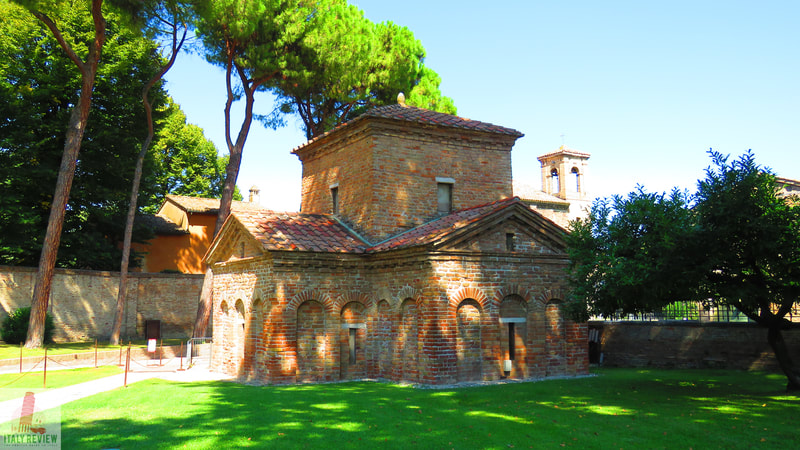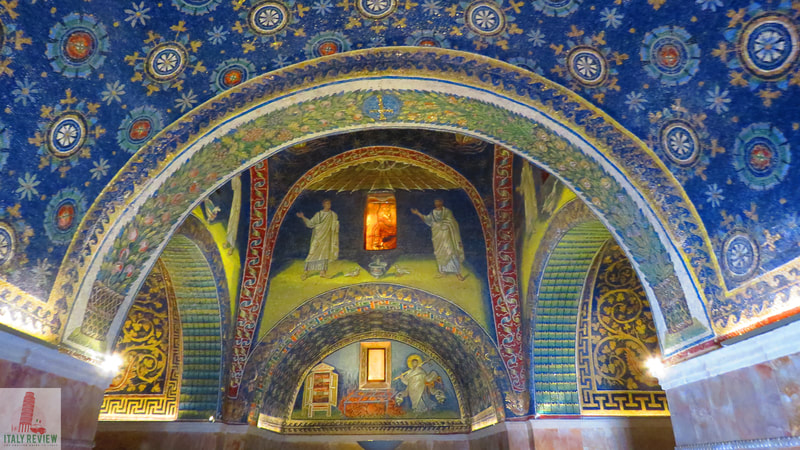Mausoleum of Galla Placidia
|
By Dion Protani
|
Latest update: 9 January 2024
|
|
The Mausoleum of Galla Placidia occupies part of the same complex as the Basilica di San Vitale in Ravenna city centre.
Built in the fifth century, it's one of eight sites, including the Basilica, that make up the Early Christian Monuments of Ravenna UNESCO World Heritage listing. Although one of the smaller sites, it's one of the most memorable with its breathtaking mosaics. |
Related links
Profile
The Mausoleum of Galla Placidia, located in Ravenna, Italy, is an exquisite early Christian monument and a UNESCO World Heritage Site. Despite its name, it is not actually the burial place of Galla Placidia, but it is a remarkable mausoleum and a testament to the art and architecture of the Late Roman and early Byzantine periods.
History
The Mausoleum of Galla Placidia was built in the 5th century AD during the reign of the Roman Emperor Honorius. Galla Placidia, the sister of Honorius and a prominent figure in the Western Roman Empire, played a crucial role in the establishment of Ravenna as an imperial capital.
While the exact purpose of the mausoleum is debated, it is widely believed to have been constructed as a tomb or memorial chapel for Galla Placidia and possibly for other members of the imperial family. Over time, it became a significant religious site and eventually became part of the complex of early Christian monuments in Ravenna.
While the exact purpose of the mausoleum is debated, it is widely believed to have been constructed as a tomb or memorial chapel for Galla Placidia and possibly for other members of the imperial family. Over time, it became a significant religious site and eventually became part of the complex of early Christian monuments in Ravenna.
Key features
- Cross-Shaped: The mausoleum has a simple Latin cross-shaped plan with a central square space and three smaller apses, one on each arm of the cross.
- Mosaics: The interior of the mausoleum is adorned with stunning mosaic artworks, depicting biblical scenes, symbolic motifs, and ornamental patterns.
- Ravenna Mosaics: The mosaics in the mausoleum are part of Ravenna's renowned collection of early Christian mosaics, showcasing the rich artistic heritage of the region.
- Romanesque Architecture: The mausoleum's brick exterior is an example of Romanesque architecture, with its unadorned facade.
Visitor information
- Historical and Artistic Significance: The mausoleum is a precious treasure of early Christian art, offering insight into the religious and cultural influences of the time.
- Mosaic Masterpieces: The stunning mosaics, characterized by their vibrant colors and intricate designs, make the mausoleum an artistic marvel.
- Historical Context: Visitors can learn about the history of the Roman Empire and its transition into the early Christian era.
- Educational Experience: Guided tours and educational materials are available to provide in-depth information about the mausoleum and its significance.
- Accessibility: The Mausoleum of Galla Placidia is easily accessible within Ravenna, along with other notable early Christian monuments in the city.
- Local Cuisine: Travelers can enjoy traditional Italian cuisine at nearby restaurants, adding to the overall cultural experience.
Mausoleum of Galla Placidia
|
Location: Ravenna
Province: Ravenna Region: Emilia Romagna Completed: 450 AD Architectural style: Ancient Roman |
Opening times vary from month to month but typically:
Summer 09:00 - 19:00 every day Winter 10:00 - 17:00 every day |
Ticket price:
A ticket for entrance to the Mausoleum of Galla Placidia by itself is not an option and you need to buy a combined ticket with access to multiple sites which costs €12.50. That said, it's great value for money as you gain access to five outstanding sites; apart from the entry to the Mausoleum itself, you also gain access to the adjacent Basilica di San Vitale, the Basilica of Sant'Apollinare Nuovo, the Neonian Baptistery and the Archiepiscopal Museum with its star attraction: the Archiepiscopal Chapel or Cappella di Sant'Andrea.
A ticket for entrance to the Mausoleum of Galla Placidia by itself is not an option and you need to buy a combined ticket with access to multiple sites which costs €12.50. That said, it's great value for money as you gain access to five outstanding sites; apart from the entry to the Mausoleum itself, you also gain access to the adjacent Basilica di San Vitale, the Basilica of Sant'Apollinare Nuovo, the Neonian Baptistery and the Archiepiscopal Museum with its star attraction: the Archiepiscopal Chapel or Cappella di Sant'Andrea.
UNESCO World Heritage Site
Early Christian Monuments of Ravenna
Year: 1996
Early Christian Monuments of Ravenna
Year: 1996























